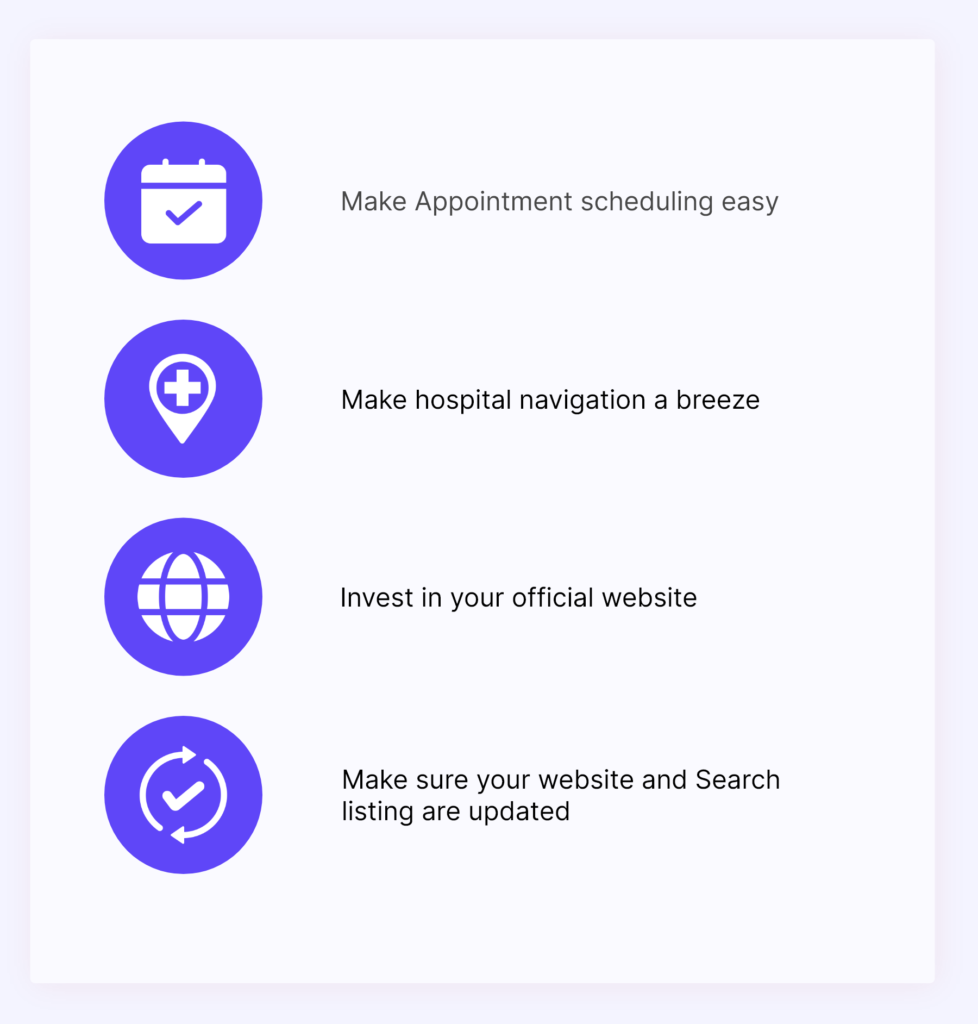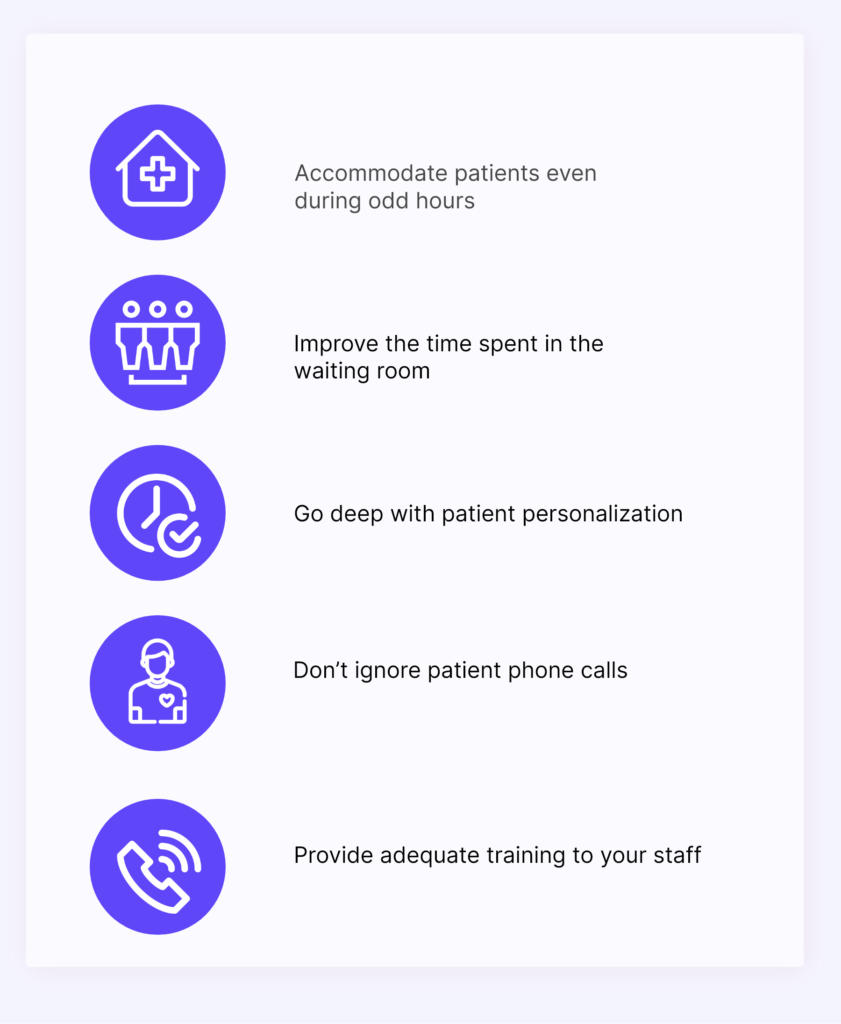Updated on September 1, 2023
“The art of medicine consists of amusing the patient while nature cures the disease.”— Voltaire
A visit to a healthcare facility is not pleasant. You have to deal with the doctors, the financial aspects of it, the mental trauma of dealing with the disease, and, most importantly, the disease itself.
Owners of healthcare organizations need to ensure that a patient visiting your healthcare facility has the best experience possible. But this is not always easy. In fact, according to this Survey by Berlyl institute, close to 60% of the Americans said they have had an outright negative patient experience in the past three months.
Why having a patient retention strategy is important:
Patient retention means there is stability in the finances of your healthcare organization. A happy patient is bound to return to your organization for follow-ups. They are also more likely to recommend your services to others. With better retention, there is also better patient outcomes since they will follow through with their treatment plans. This will lead to reduced healthcare costs. Repeat visits to the hospital also means doctors can diagnose serious ailments easily, leading to reduced costs.
Not having a good patient retention strategy in place means there will be reduction in revenue. This is because patients may choose to seek care elsewhere. There can be a negative reputation for your healthcare organization. This will lead to a reduction in the number of referrals. One final risk of not having a good patient retention strategy is that patients may no longer be loyal to your healthcare organization.
Patients today are educated, since information on various diseases and their treatment methodology is available at their fingertips. This means healthcare institutes need to revisit their retention strategy to stay relevant in todays times.
So what can you do to ensure that the patients who visit your healthcare facility have the best experience possible? Well, for starters, you can check out these 9 strategies listed below.
These strategies will help you build long lasting patient relationships, and are easy to implement. So, what are you in the waiting room for? Let’s quickly begin our examination.

Strategy 1 – Make Appointment scheduling easy
A patient is already under some or other form of distress, and we don’t want to add to their woes by making appointment scheduling a pain. Most healthcare providers these days have phone numbers listed on their websites which the patients can use to book appointments, but what if there was another way?
We are talking about chatbots, one of whose chief use cases is appointment scheduling. Building a chatbot is not difficult, and you can be up and running with a chatbot in a matter of minutes. Your business hours and the time that the patients would like to book appointments may differ. A chatbot, being available 24 x 7, will help you bridge this gap.
It should not take more than 2 minutes for your patients to book an appointment with your healthcare facility. With chatbots, the monotony of filling out dozens of forms is eliminated. Chatbots can also provide information on doctor availability. Ensure that the patients who decide to visit your healthcare facility have an easy time making an appointment. This will be a major win for your organization.
Strategy 2: Make hospital navigation a breeze
Once the patients book their appointments, it is now important to make sure they have an easy time when they visit your healthcare facility. Some of the patients may have mobility issues, and it is up to you to ensure that everyone can easily get around the hospital.
You must place wheelchairs and stretchers strategically across different parts of the hospital so that patients don’t have to walk to various departments. The entrance and waiting areas must have a comprehensive map of the entire facility. If possible, you can develop a mobile app or touchscreen directories that will guide your patients turn by turn.
Mark out the labs, waiting rooms and ward clearly. This is so that patients don’t have to make lengthy rounds of the hospital to avail healthcare. Also, make sure that there are enough staircases and lifts to cater to patients who come in with emergency medical conditions. All of these will leave a lasting impression on your patients. They will keep coming back to you for their healthcare needs.

Strategy 3: Invest in your official website
A professional looking website is the first impression for any patient planning to visit your healthcare facility. Make sure that you invest enough time and resources in building this website. Having a friendly face on the homepage, preferably from one of your staff members, makes your visitors feel welcome to your website.
Make sure that your website is easy to navigate. This means having all the information presented clearly in different pages. Font size, Color scheme and background, everything is important on your website, because some of the patients visiting your site may have difficulty reading.
If the patients are coming to your website for the first time, make sure to have all the important information. This can be information such as visiting hours, location, doctor’s credentials and contact number all listed carefully on the site.
Strategy 4: Make sure your website and Search listing are updated
A patient may not remember your hospital’s name just by your website’s URL. The trick here is to optimize your website so that it ranks high on Search Engines. One such technique here is to educate your incoming website visitors about all the services that you provide.
Writing exhaustive blog posts about various diseases for which treatment is available at your healthcare facility is another way to stay relevant in your patient’s mind. John Hopkins Medicine center is an excellent example of how hospitals can attract patient’s attention through disseminating information. As a healthcare provider, you must also update your Google Business listing regularly. This is so that your information comes up quickly on Google Search results.

Strategy 5: Accommodate patients even during odd hours
Regular office hours may not suit all the patients, since some of them may also need to go to their workplaces during the same time. And hospitals also have a bad reputation when it comes to serving patients outside business hours.
In a recent study, Americans were tasked with responding to the quality of treatment received while visiting a hospital during weeknights, weekends and holidays. 15% of the people who gave answers to the survey say that they received medical care that was far worse than those who visited the healthcare facility during regular business hours.
Bonus tip – try and be open for business when all other healthcare facilities that are in your vicinity are closed. This will reinforce the belief in patients that you are a hospital that meets a patient’s medical needs even during odd hours. Implementing a chatbot on your website is another way to ensure patients get answers to their queries around the clock.

Strategy 6: Improve the time spent in the waiting room
When you are suffering from a disease, you really don’t want to spend a majority of the time waiting for the doctor to arrive. This is especially true if the patient is under a lot of pain. In fact, research by Phreesia shows that 1 out of 5 patients will permanently move to a different healthcare provider due to long waiting times.
One way to reduce waiting time is to schedule doctor’s appointments in an organized manner, and again, chatbots can come to the rescue here. The next step in improving the waiting room experience is to holistically look at the waiting room itself.
To gauge the effectiveness of your waiting room, try and spend a small amount of time in the waiting room every alternate month. Providing comfortable furniture and magazines to keep the patients engaged. This is one of the most basic steps you can take to improve waiting room experience.
Creating a positive patient experience in the waiting room can help in improving retention. It will also ensure that the patients return next time they have a similar ailment.
Strategy 7: Go deep with patient personalization
Patients tend to come back to your healthcare facility if you show them that you actually care about their well being. One way to ensure this is patient personalization. When you remember a patient’s name and their ailment after they are done with their first visit, they feel happy.
A personalized chatbot, for example, can fetch data from previous interactions and respond to the patients accordingly. Every patient wants to feel special and valued. For instance, carry out small talk with the patient before the actual consultation begins. This will leave a positive impression in their minds.
You can also use the information provided by the patients to create a personalized care plan. You can tailor these plans to suit the needs of individual patients. This can be done by taking into account various factors such as their age, medical history, preferences etc.
Creating personalized care plans may be time consuming and resource intensive. But it is well worth the effort since it greatly impacts the patient experience.
Strategy 8: Don’t ignore patient phone calls
While we have been highlighting the advantages of chatbots all through this blog, you must also keep in mind that some patients might not be as tech savvy. Many customers prefer a real person at the other end of the line to answer their queries. They don’t mind waiting for a minute or two to get answers rather than getting an automated response that feels too mechanical.
The first step to ensure that your patient’s queries are answered is to prominently display your phone number on your hospital’s website, along with the hours patients can expect a phone reply from. Train your staff to be polite and treat patients with the utmost respect when answering their queries over the phone.
Make sure that your most senior employees man the phone lines, since their invaluable experience can help them resolve patient queries faster. Post business hours, you can redirect the calls to an IVR. Make sure that these calls are also addressed within 24 hours.

Strategy 9: Provide adequate training to your staff
A healthcare institute may get patients from all walks of life, and it is important that your staff deal with each of them appropriately. Irrespective of the age, gender, race, financial status, etc. of a patient, you must treat everyone equally. This is where training plays a big part.
Have regular meetings with your team members and enquire about the most commonly arising queries from patients. You can then use these queries to train other members of the staff, who may also face them in the future. If you are implementing chatbots on your website, you can turn these queries into FAQs, which your chatbot can answer.
At the end of the day, patients want to feel taken care of by your healthcare facility. A kind word or a gesture by your staff can go a long way in accomplishing this. Be it soft skills training or email etiquette, continuously investing in the training of your staff can help in ensuring that your patients keep coming back to your facility.
Conclusion
Patient retention is a challenge to any healthcare organization, and we hope these 9 strategies will help you in one way or another. Remember, reading about making patients happier is one thing. Implementing these strategies and actually driving results is a whole different ball game. Take care of your patients, and they, in turn, will take care of the continued success of your healthcare facility.

At Kommunicate, we envision a world-beating customer support solution to empower the new era of customer support. We would love to have you on board to have a first-hand experience of Kommunicate. You can signup here and start delighting your customers right away.






